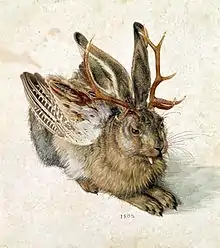
.jpg.webp)
In German folklore, a Wolpertinger (also called Wolperdinger or Woiperdinger) is an animal[1] said to inhabit the alpine forests of Bavaria and Baden-Württemberg in Southern Germany.
Description
It has a body comprising various animal parts – generally wings, antlers, a tail, and fangs; all attached to the body of a small mammal. The most widespread description portrays the Wolpertinger as having the head of a rabbit, the body of a squirrel, the antlers of a deer, and the wings and occasionally the legs of a pheasant.
Stuffed "Wolpertingers", composed of parts of real animals that have been stuffed, are often displayed in inns or sold to tourists as souvenirs in the animal's "native regions". The Deutsches Jagd- und Fischereimuseum in Munich, Germany features a permanent exhibit on the creature.
It resembles other creatures from German folklore, such as the Rasselbock of the Thuringian Forest, the Dilldapp of the Alemannic region, and the Elwedritsche of the Palatinate region, which accounts describe as a chicken-like creature with antlers; additionally the American Jackalope as well as the Swedish Skvader somewhat resemble the wolpertinger. The Austrian counterpart of the Wolpertinger is the Raurakl.
According to folklore, Wolpertingers can be found in the forests of Bavaria. Variant regional spellings of the name include Wolperdinger, Woipertingers, and Volpertinger. They are part of a larger family of horned mammals that exist throughout the Germanic regions of Europe, such as the Austrian Raurackl, which is nearly identical to the German Wolpertinger.[2]
In popular culture
- Rumo, a 'Wolperting' is the main character of the novel Rumo and His Miraculous Adventures by Walter Moers, depicted as an anthropomorphic dog with horns.[3]
See also
- Al-mi'raj
- Bunyip
- Elwetritsch
- Jackalope
- Lepus cornutus
- Rasselbock
- Skvader
- Shope papilloma virus, a possible inspiration of the fangs and antlers.
- Wendigo
References
- ↑ Axton, Myles (2006). "Molecular gaze for the sci guy". Nature Genetics. Academic OneFile. 38 (3): 269. doi:10.1038/ng0306-269. S2CID 29884157. Retrieved 1 April 2018.
- ↑ "Wolpertinger".
- ↑ "Rumo & His Miraculous Adventures". Publishers Weekly. Reed Business Information. July 24, 2006. Archived from the original on February 12, 2017.
Further reading
- Heim, Michael; Reiser, Hans (20 December 2012). Mit dem Wolpertinger leben. Ein Verhaltensratgeber [Living with the Wolpertinger: A Behavioral Guidebook] (in German). Edition Lipp. pp. 1–70. ISBN 978-3874907606.
- Huber, Reginald (1 February 1999). Vom Adler bis zum Wolpertinger. Das bairische Bestiarium. Mit sensationellen Fotos von A. & G.R. Kaut [From the Eagle to Wolpertinger. The Bavarian Bestiary. With Sensational Photos by A. & G.R. Kaut] (in German) (Hardcover ed.). Dachau (Germany): Bayerland GmbH. pp. 1–136. ISBN 978-3892511885.
- Kirein, Peter (1 January 1968). Der Wolpertinger lebt. (Warum die Bayern mehr Haare haben) [The Wolpertinger Lives. (Why the Bavarians Have More Hair)] (in German). Verlag Karl M. Lipp. ISBN 3-87490-501-2.
- Schallweg, Paul (16 September 2015). Der Wolpertinger - Das bayrische Urviech [The Wolpertinger - The Primeval Bavarian Creature] (in German). Rosenheimer Verlagshaus. pp. 1–94. ISBN 978-3475544798.
- Schweiggert, Alfons (1 January 1988). Und es gibt sie doch! Die Wahrheit über die Wolpertinger [And They Do Exist! The Truth about Wolpertingers] (in German). Pfaffenhofen, Germany: Ludwig Verlag. pp. 1–56. ISBN 978-3778733257.
- Schweiggert, Alfons (1 June 1998). Der Wolpertinger oder der gehörnte Hase. Eine ernsthafte Untersuchung eines bayerischen Phänomens [The Wolpertinger or the Horned Rabbit. A Serious Investigation of a Bavarian Phenomenon] (in German). Ludwig Verlag. pp. 1–120. ISBN 978-3778734759.
External links
 Media related to Wolpertinger at Wikimedia Commons
Media related to Wolpertinger at Wikimedia Commons